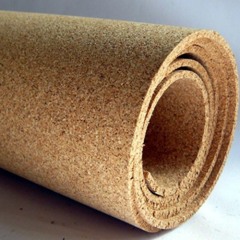Cork Flooring
Cork Flooring, Cork Wallcoverings and Cork Underlayments
Cork is a material that grows as the bark of the Cork Oak tree. More than half of the world's cork found in Mediterranean Countries. The bark of the mature Cork Oak tree is harvested about every 9 years, and it is allowed to dry for 1 to 2 years. Cork trees are not regarded as mature enough for bark harvesting until they are at least 25 years old. Harvesting requires the delicate stripping of the outer bark by skilled workers using specialized cork axes. The stripping is carried out in spring or summer when the tree is growing strongly and the bark comes away easily from the trunk. Unlike any other tree there is only one section of cork oak tree can be used for cork floors and that is the rutermost layer of the bark which contains a substance call suberin. The tree is temporarily debilitated by the stripping but the outer bark regenerates and the tree continues to flourish. Next it is boiled to remove any toxins or other harmful agents, and then it is graded and cut. After a final cleaning and drying, the cork is sorted and ready for use.
Cork bark is made up of a tiny sealed honeycomb cellular structure (14-sided polyhedrons) containing gas of 90% air. These cells provide resiliency (cushion) and insulation and there are about 40 million cells per cubic centimeter, and each of these cells functioning as a miniature shock absorber. The spaces between them, are filled with a gaseous mixture similar to air. The suberin is highly resistant to fire and water penetration and most commonly used for wine bottle stoppers, but it can also be found in bulletin boards, flotation devices, musical instruments and floor tiles. Cork can be compressed up to 40% and quickly returns to its original shape. This all works to make cork a very special Flooring Material such as Cork Tiles and Cork Planks with click system.
Why Cork Flooring
Cork floor is a healthy green flooring choice and good investment that when properly maintained, will last for generations. A big part of the green story for cork is that you don't cut down the tree; rather the bark is stripped off the tree and the tree stands there naked, as it were, and it won't be denuded for another nine years. The tree lives and customer has a cool looking floor; talk about sustainable! Comprised of green, renewable natural material, Cork Flooring is eco-friendly. It promotes improved health and comfort for green indoor environment. Cork Flooring creates a warm, comfortable, resilient surface that is non-allergenic, gentle underfoot, is anti-microbial, fire-resistant, thermal insulator, and is inherently resistant to molds, mildews, and common pests such as termites. It is water resistant and absorbs sound providing superb acoustical properties.
Common Uses of Cork Floors
Cork Flooring is comfortable to walk on and providing a cushion for your feet. The softness and resilience of the flooring causes less of a grinding action to occur with heavy traffic conditions, no matter how much it is walked on. It's been popular for use in home for a child's room, family room, kitchen or bath, an excellent choice for public buildings such as schools, hospitals, churches, banks, libraries, court houses and other government buildings.
Cork Floor Care and Maintenance
Cork Flooring care is very easy and because it is a wood product, it needs to be treated like hardwood floor and with a little effort your floor should last for years. After installation of your new cork flooring we suggest to:
1) Using a doormat in doorways (avoid using doormat with non-porous backing, so cork floor be able to breath).
2) Use felt pad under furniture's legs.
3) Furniture must be lifted at the time of moving, avoid dragging them.
4) Prevent your Cork Floor from direct sunlight with window treatments.
To clean your Cork Floor, sweep or vacuum it regularly. Use hardwood cleaner to clean heavier soiled area. Do not use any strong chemicals.






